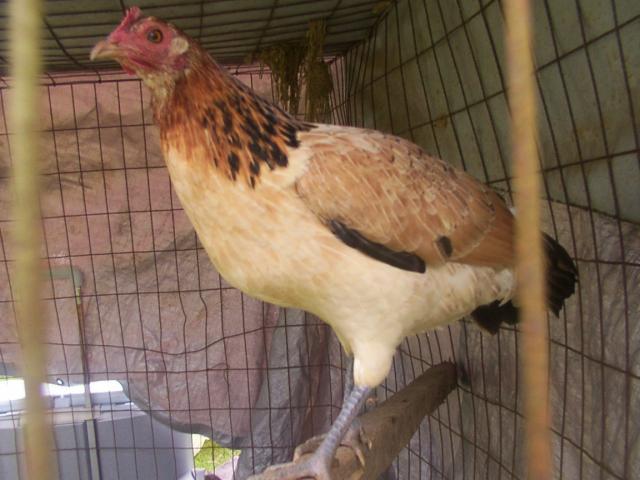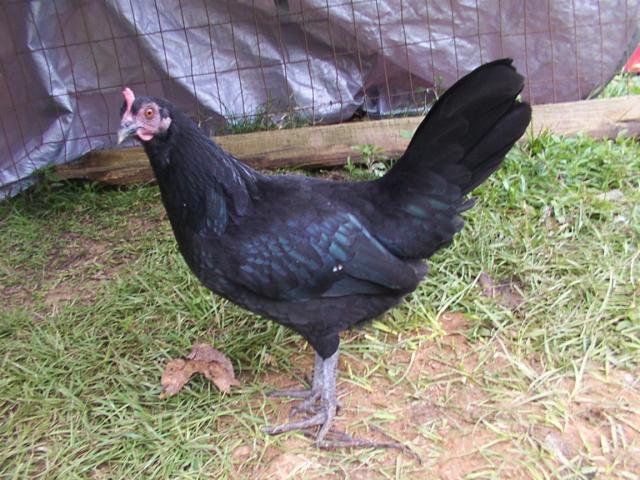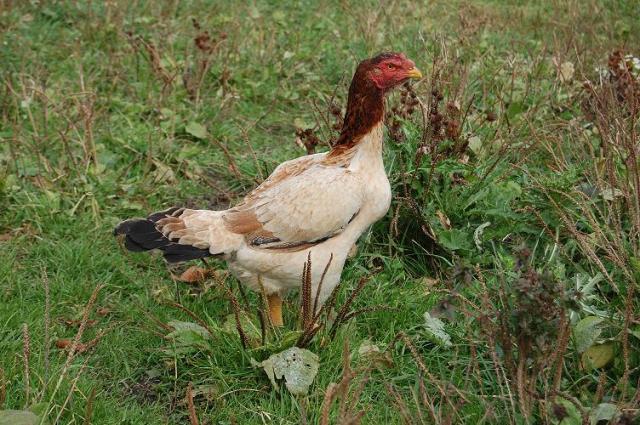Quote:
Firstly, I didn't think Yokohamas were considered a game breed? I thought they were a long-tailed ornamental breed.
Secondly, I was also unaware that there was a Silver Duckwing Yokohama or that McMurray carried one... Are you sure she isn't a Silver Phoenix pullet?
I think she has a pea comb, hard to tell but it doesn't look like a single comb. And off the top of my head I can't remember what leg color should be for either breed...
Breed name: Yokohama (Minohiki)
Habitat: Japan
Classification: Sumatroid
Background information:
The Yokohama is not seen as a pure gamefowl by the majority of gamefowl breeders. But Japanese studies on genetics concerning the origin of their domestic breeds showed clearly that the Yokohama has been created using the Shamo and the Shokoku, the latter a longtailed fowl originally being imported from China in the Heinan period (794-1186). In Japan there is no fowl known or standarized as Yokohama. However one particular Japanese breed shows the same features, the "Minohiki". In its homeland Japan this breed is dominantly bred in the Aichi and Shizuoka province. The first birds introduced into the West in 1864 by a French priest called Girard must have been renamed to a more European sounding name. This has been done several times in gamefowl history. In 1869 a German master of fencing, Prosche from Dresden introduced the breed into his country. There the breed got very popular. However Yokohama's miss that sturdy appearance looking very elegant they are quit hardy. They have been kept and bred succesfully in various harsh regions of Germany. Yokohama's due their long well developed tail must be kept in large coops. Typical features: a small head with orange-red eyes (originally the first imported specimins had pearlish eyes which are a clear feature of Malayoid fowl). Small triple peacomb, short beak, legs of medium position, the shanks yellow of colour. The back is slightly inclining, its tail horizontally or slightly drooping. The tail of a Yokohama is not marked by very long sickle feathers but the well developed saddle feathers. Weight: male 4.4 Lbs (2.0 Kg), female 3.3 Lbs (1.5 Kg). Their are no Japanese or Western records showing any evidence that the Yokohama (Minohiki) ever have been used as pure pitfowl. In ancient China the longtailed Shokoku has been used as "temple fighters" and were fought during religious events.
Sources: "Kämpfer und Zwerg-Kämpfer der Welt" (1983) by Wilfried Detering (Germany)
Picture: illustration taken from "Brehms Tierleben" (1882) by Gustav Mützel (Germany)
Display: a pair of the original stock imported into Germany from Japan by Hugo du Roi (Germany)
THATS SOME BACKGROUND ON THE YOKOHAMAS There are silver duckwing yokohamas, red shoulder, there are white, theres are golden and there are a couple of blacks out there (VERY RARE THO). i saw one in a show in Puerto rico all black, not sumatra but yokohama. But it was my mistake i wrote mc murray but its actualy cackle hatchery that carries them.
Firstly, I didn't think Yokohamas were considered a game breed? I thought they were a long-tailed ornamental breed.
Secondly, I was also unaware that there was a Silver Duckwing Yokohama or that McMurray carried one... Are you sure she isn't a Silver Phoenix pullet?
I think she has a pea comb, hard to tell but it doesn't look like a single comb. And off the top of my head I can't remember what leg color should be for either breed...
Breed name: Yokohama (Minohiki)
Habitat: Japan
Classification: Sumatroid
Background information:
The Yokohama is not seen as a pure gamefowl by the majority of gamefowl breeders. But Japanese studies on genetics concerning the origin of their domestic breeds showed clearly that the Yokohama has been created using the Shamo and the Shokoku, the latter a longtailed fowl originally being imported from China in the Heinan period (794-1186). In Japan there is no fowl known or standarized as Yokohama. However one particular Japanese breed shows the same features, the "Minohiki". In its homeland Japan this breed is dominantly bred in the Aichi and Shizuoka province. The first birds introduced into the West in 1864 by a French priest called Girard must have been renamed to a more European sounding name. This has been done several times in gamefowl history. In 1869 a German master of fencing, Prosche from Dresden introduced the breed into his country. There the breed got very popular. However Yokohama's miss that sturdy appearance looking very elegant they are quit hardy. They have been kept and bred succesfully in various harsh regions of Germany. Yokohama's due their long well developed tail must be kept in large coops. Typical features: a small head with orange-red eyes (originally the first imported specimins had pearlish eyes which are a clear feature of Malayoid fowl). Small triple peacomb, short beak, legs of medium position, the shanks yellow of colour. The back is slightly inclining, its tail horizontally or slightly drooping. The tail of a Yokohama is not marked by very long sickle feathers but the well developed saddle feathers. Weight: male 4.4 Lbs (2.0 Kg), female 3.3 Lbs (1.5 Kg). Their are no Japanese or Western records showing any evidence that the Yokohama (Minohiki) ever have been used as pure pitfowl. In ancient China the longtailed Shokoku has been used as "temple fighters" and were fought during religious events.
Sources: "Kämpfer und Zwerg-Kämpfer der Welt" (1983) by Wilfried Detering (Germany)
Picture: illustration taken from "Brehms Tierleben" (1882) by Gustav Mützel (Germany)
Display: a pair of the original stock imported into Germany from Japan by Hugo du Roi (Germany)
THATS SOME BACKGROUND ON THE YOKOHAMAS There are silver duckwing yokohamas, red shoulder, there are white, theres are golden and there are a couple of blacks out there (VERY RARE THO). i saw one in a show in Puerto rico all black, not sumatra but yokohama. But it was my mistake i wrote mc murray but its actualy cackle hatchery that carries them.









